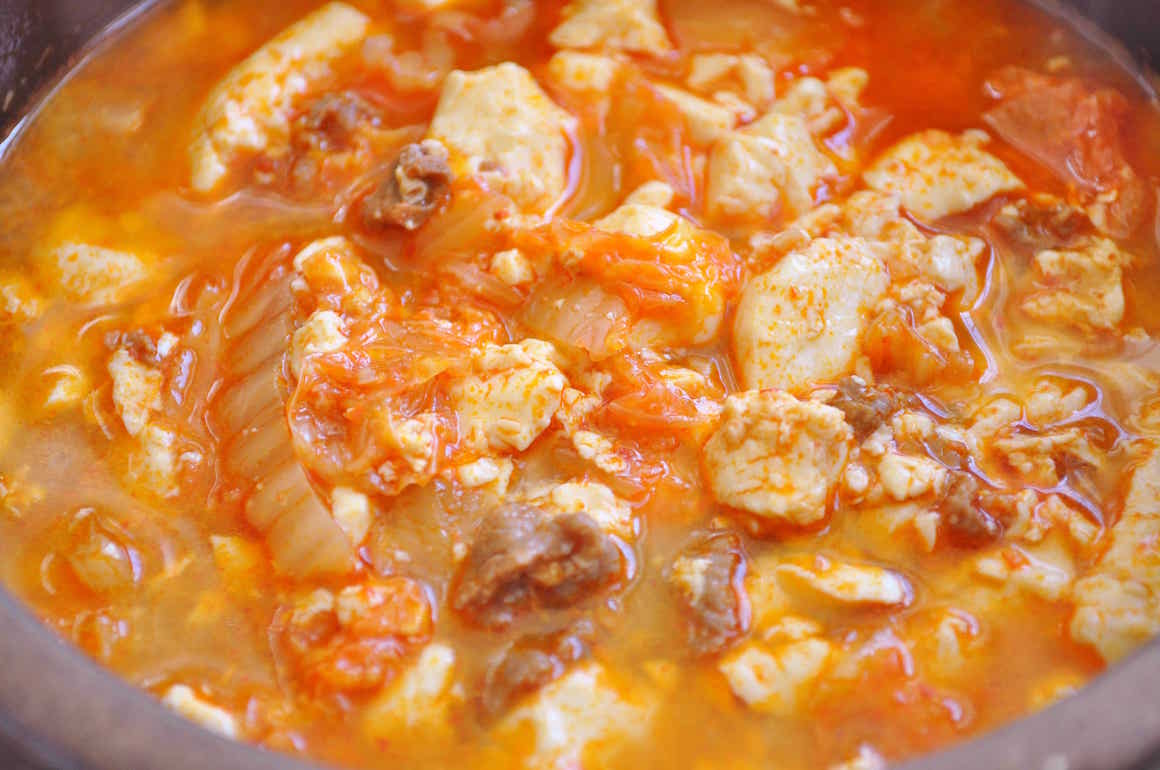
Soondubu Jjigae with Kimchi (김치 순두부찌게)
Soondubu Jjigae with Kimchi is one of the variations of the spicy soft tofu stew (순두부 찌게 Soondubu Jjigae) that I wrote about some time ago. I know that my original recipe may taste a bit bland to some people and if that’s the case for you, you really have to try this version with kimchi and beef. As with many things, adding kimchi makes the jjigae explode with flavors that are just beyond words. How anyone can live without kimchi, I’ll never know… 🙂
However, if you cannot get kimchi or feel that it is too strong, sauerkraut is a good substitute for kimchi. It does not have all the full complex flavors of the garlic and the fermented fish sauces but it does provide the sourness similar to that of kimchi. At one of our family reunions several years ago–we did not have access to a Korean grocery store– and my sis #3 made a pseudo kimchi jjigae by using sauerkraut, pork, garlic and tons of red chili pepper and it was actually really good. She also made a mock kimchi fried rice which was great!
I used the gochu yangnyeom (chili sauce) that I already made before so it was really simple. I have to confess that I still had the leftover yangnyeom from the time I made it for my post in MAY! I thought it would have spoiled by now but surprisingly it was still good! Oh, how I love my sub-zero fridge…if it wasn’t for my sub-zero fridge, I’m quite sure the yangnyeom would not be useable by now. A Sub-zero fridge really keeps everything fresh for a much longer period. Fruits and vegetables also don’t get shriveled up for at least a couple weeks -which I love.
Soondubu Jjigae with Kimchi Recipe
Ingredients
- 1 pack (11 oz) of extra soft tofu (순두부 Soondubu)
- 1/2 C water
- 1 T gochu yangnyum (chili sauce – see original soondubu jjigae post for recipe)
- 2- 3 oz beef (stew meat) or pork(belly), cubed – optional
- 4 oz kimchi (about 1/2 C), roughly chopped
- 1 egg (optional)
Directions
Once you have the gochu yangnyum (chili sauce) already made, it really is very simple to make.
1. Measure about 1/2 C of well fermented kimchi (a handful) and chop it roughly into small pieces or slice into thin strips. It’s always best to use fully fermented, ripe kimchi when it’s used for cooking. When the kimchi is fully fermented, the smell is more pungent but the taste is smoother than when it’s freshly made. A ripe kimchi is slightly sour but has a zing to it that you just cannot taste in any other dish. The sourness will increase as the fermentation process continues and it’s just a matter of personal taste how sour you want your kimchi to be.
2. Cut up beef or pork into small cubes. The amount of meat doesn’t have to be exact. Use either a similar amount or less of meat when compared to the amount of kimchi. In my opinion, pork goes better with kimchi. There is just something about pork that makes kimchi taste 10 times better. And so if you like pork, by all means use pork! I used beef here because my hubby is allergic to pork…sigh..
3. Add the kimchi and the meat to your hot pot and cook over medium high heat for 2-3 minutes until meat is slightly cooked.
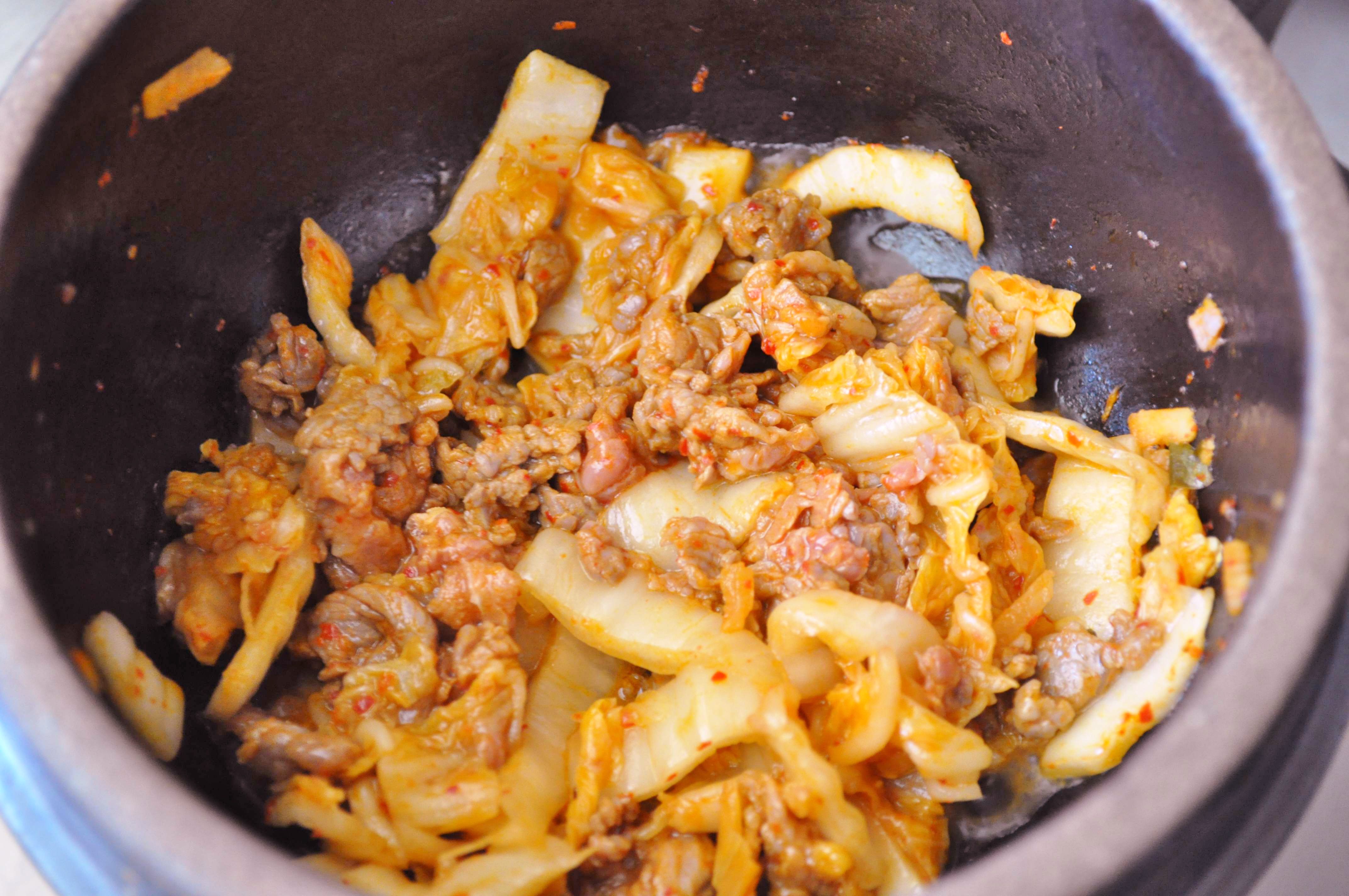
4. Add 1/2 C water and tofu. Break up the tofu into smaller pieces so the tofu gets seasoned evenly. Add 1 T gochu yangnyum and bring to a boil. Let it simmer for 10 minutes. Taste and add salt if necessary. When kimchi is added, you will most likely not need any additional soy sauce or salt or saewoojeot because kimchi is already quite salty.
If you like eggs, crack an egg and add it to the pot when you are ready to eat. You can break up the egg if you like or leave it whole. If you like it fully cooked, let it cook fully on the stove. If you like your eggs to be soft in the middle, take the jjigae off the heat as soon as you add the egg and let it cook slowly in the residual heat.
So that’s how you make kimchi soondubu jjigae! Serve it with some rice, some less spicy, savory jeons or meat dishes like bulgogi. Add a refreshing salad or fresh vegetable dish and it should be a very healthy and tummy warming meal.
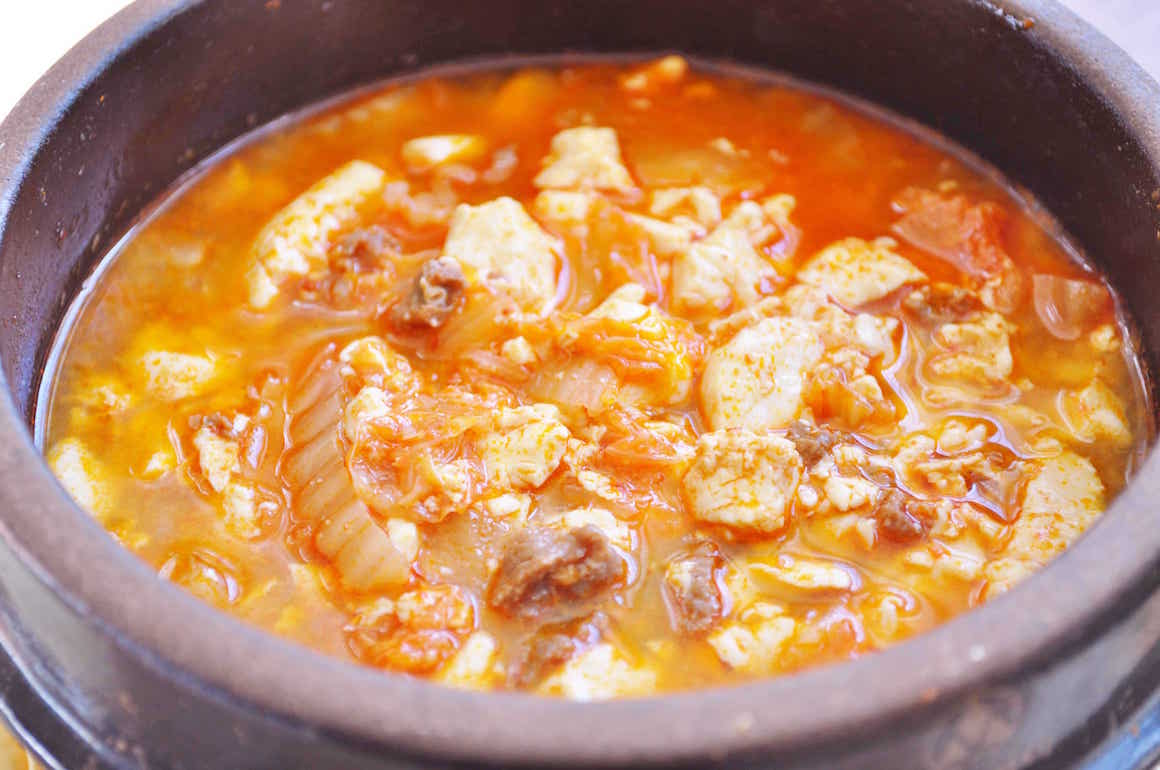
Kimchi Soondubu Jjigae (Spicy Soft Tofu Stew with Kimchi)
Ingredients
- 1 pack extra soft tofu (순두부 Soondubu) (순두부 / Soondubu, 1 pack is 11oz / 311.85g extra soft tofu)
- 1/2 cup water
- 1 Tbsp gochu yangnyum (chili sauce) (see notes)
- 2- 3 oz beef (stew meat) or pork belly, cubed (optional)
- 4 oz kimchi (or 1/2 cup, roughly chopped)
- 1 egg (optional)
Instructions
- Once you have the gochu yangnyum (chili sauce) already made, it really is very simple and quick to make. Get the recipe here.
- Measure about 1/2 cup of well-fermented kimchi (a handful) and chop it roughly into small pieces or slice into thin strips.
- Cut up beef or pork into small cubes. The amount of meat doesn’t have to be exact. Use either a similar amount or less meat when compared to the amount of kimchi. In my opinion, pork goes better with kimchi.
- Add the kimchi and the meat to your hot pot and cook over medium high heat for 2-3 minutes until meat is slightly cooked.
- Add 1/2 cup water and tofu. Break up the tofu into smaller pieces so the tofu gets seasoned evenly. Add 1 Tbs gochu yangnyum and bring to a boil. Let it simmer for 10 minutes. Taste and add salt if necessary. When kimchi is added, you will most likely not need any additional soy sauce or salt or saewoojeot because kimchi is already quite salty.
- If you like eggs, crack an egg and add it to the pot when you are ready to eat. You can break up the egg if you like or leave it whole. If you like it fully cooked, let it cook fully on the stove. If you like your eggs to be soft in the middle, take the jjigae off the heat as soon as you add the egg and let it cook slowly in the residual heat.
- Serve with rice, some less spicy, savory jeons or meat dishes like bulgogi. Add a refreshing salad or fresh vegetable dish and it should be a very healthy and tummy warming meal.
Tips & Notes:
- Get the recipe for gochu yangnyum in my original soondubu jjigae post.
- It’s always best to use fully fermented, ripe kimchi for cooking. When the kimchi is fully fermented, the smell is more pungent but the taste is smoother than when it’s freshly made. A ripe kimchi is slightly sour but has a zing to it that you just cannot taste in any other dish. The sourness will increase as the fermentation process continues and it’s just a matter of personal taste how sour you want your kimchi to be.
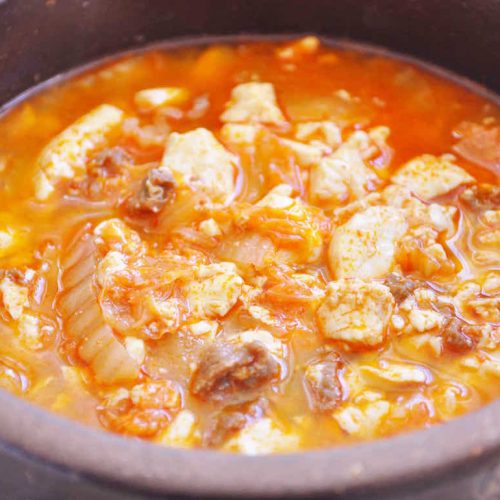
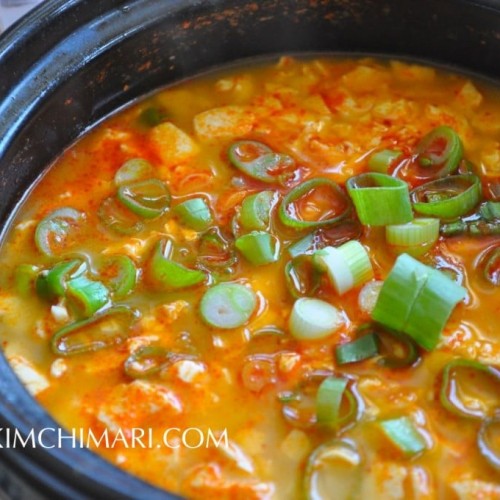
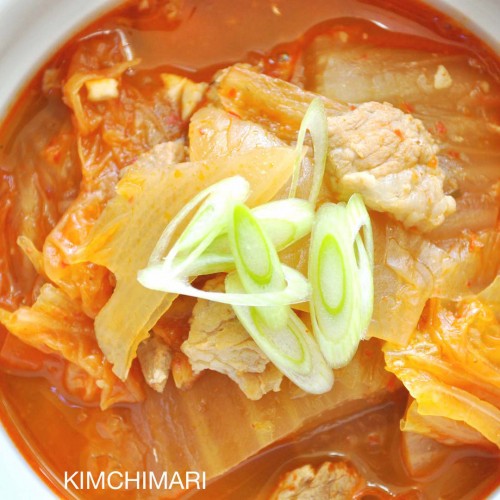

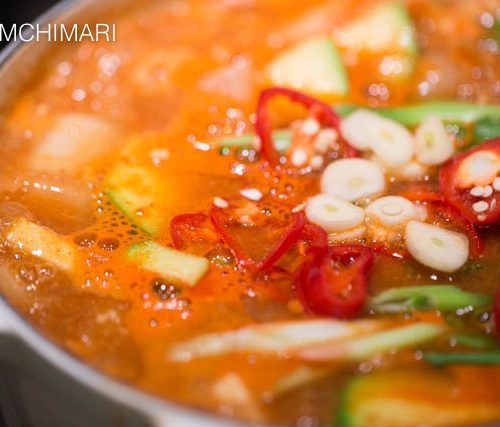















Can I replace gochujang for gochu yangnyum?
Well, not completely. YOu can certainly add gochujang but the yangnyum as lot more of other seasoning and flavors that makes the jjigae yummy. Thank you!
Great!
Thank you so much for this recipe! My husband and I love it, and it’s so easy to make when I get home later after work (I make a big batch of gochu yangnyum and keep it in the fridge, which makes prep time really quick.)
You are so welcome! I know isn’t it great?!! My daughter loved having the soft tofu stew yangnyum at her dorm. Thank you so much for your comment!! really made my sunday! Enjoy~^^
Thanks for sharing your recipes…I just made the stirred fried shrimps – it is an awesome side dish! Really tasty : ) Can I use corn syrup instead of rice syrup next time? I am going to try making the kimchi Jjigae for dinner.
Sure, you can use corn syrup too. Be careful not to use too much because it can make it too sweet and also too sticky. Good luck in making Kimchi Jjigae and thanks for asking!
Wow, perfect timing! 순두부 찌게 is almost my favorite food, and I have a huge crock of homemade kimchi that is really more than I can finish soon. So this is a great idea.
I just wanted to say that I especially appreciate that you include Hangul when you write. I end up lost in the aisles at Hankook grocery trying to figure out what I need from someone’s bad Romanization and it’s hopeless. But I’ve learned enough so that I can read the non-Roman labels, so you at least give me a chance. Plus, you help me learn more. Thanks! And as a single person, I appreciate that your recipes aren’t designed to feed an extended family of 3 generations like so many are.
One question: can I use anchovy sauce instead of oyster sauce in the yangnyum? I’m bewildered by the oyster sauces – can you recommend a brand with something so that I can recognize the label?
I still haven’t gotten up to Filoli – maybe next spring. You’re an inspiration!
So great to hear your comments! Thank you. Yes, since I mostly cook for just my husband and myself now, 2-3 servings has become my usual.
I’m sure anchovy sauce will work fine instead of oyster sauce. Since oyster sauce is originally Chinese, Lee Kum Kee is the most known brand. But I have recently found a Korean brand- CJ’s baeksul oyster sauce (굴쏘스) http://english.cj.net/company/news/press/press_view.asp?ps_idx=1248&NO=314. The taste is similar but it’s a smaller bottle and it doesn’t contain MSG.
Another good way to use up kimchi is to make kimchi fried rice (posted already) and then of course, kimchi jjigae (hope to post soon).
Yes, Filoli should be beautiful in spring!
I found the oyster sauce! Thanks for the picture. Yes, your kimchi fried rice is on my agenda. I have a few recipes for kimchi jigae but none that I love, so I’ll look forward to yours. Thanks again.
Glad you found it! Yes, I will post about kimchi jjigae the next time I make it.